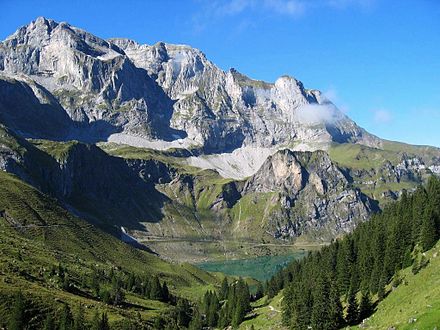Nidwalden
Nidwalden, also Nidwald (German: (Kanton) Nidwalden, [ˈnidˌvaldən] (listen)![]() ) is one of the 26 cantons forming the Swiss Confederation. It is composed of eleven municipalities and the seat of the government and parliament is in Stans. It is traditionally considered a "half-canton", the other half being Obwalden.
) is one of the 26 cantons forming the Swiss Confederation. It is composed of eleven municipalities and the seat of the government and parliament is in Stans. It is traditionally considered a "half-canton", the other half being Obwalden.
Nidwalden lies in Central Switzerland. It borders the canton of Obwalden to the west, the cantons of Lucerne and Schwyz to the north, the canton of Uri to the east and the canton of Bern to the south. The canton is essentially in the Alps, south of Lake Lucerne.
It is one of the smallest cantons, the population is 40,287 (in 2007).[3] The largest town is Stans, followed by Hergiswil and Buochs.
Together with Obwalden, Nidwalden was part of the forest canton of Unterwalden, one of the three participants in the foundation of the Old Swiss Confederacy, named in the Pact of Brunnen of 1315 with Uri and Schwyz. The division of Unterwalden into two separate territories, Obwalden and Nidwalden, appears to develop over the course of the 14th and 15th centuries.
The earliest traces of human settlement date to the Neolithic with sites found near Stansstad that are from 4000 to 3100 BC.[4] The same sites, near Stansstad, also contain Late Bronze Age (1400–1100 BC) artifacts, with additional Bronze Age sites near Hergiswil and Ennetmoos. A La Tène (500–100 BC) grave for a 10-year-old girl has been found in Stans. Based on these finds, it appears that the Nidwalden region has been settled since the 1st millennium BC.[4]
During the Roman Empire Ob and Nidwalden were inhabited by a Gallo-Roman or Celtic population. While there are few artifacts from the population, many names of the towns, rivers and mountains have either Celtic or Gallo-Roman roots.[4] By the 8th century the Alemanni entered the valleys of present-day Nidwalden and intermingled. At this time a Roman Catholic church was built in Stans, most likely founded by an Alemanni noble family. The church in Stans would remain until the 10th century when it was replaced by a church in Buochs.[4]

